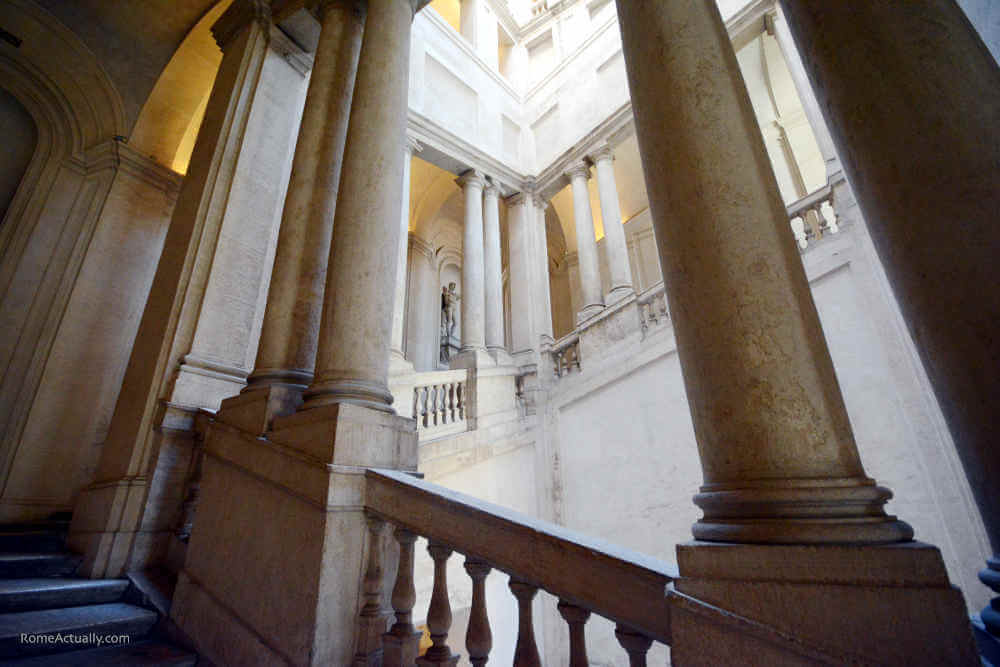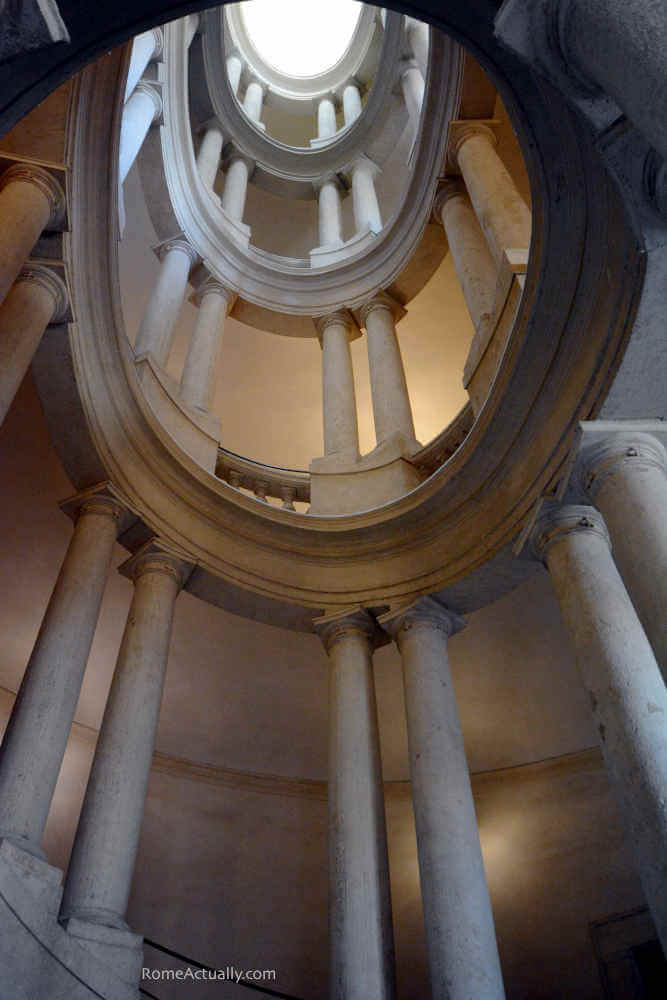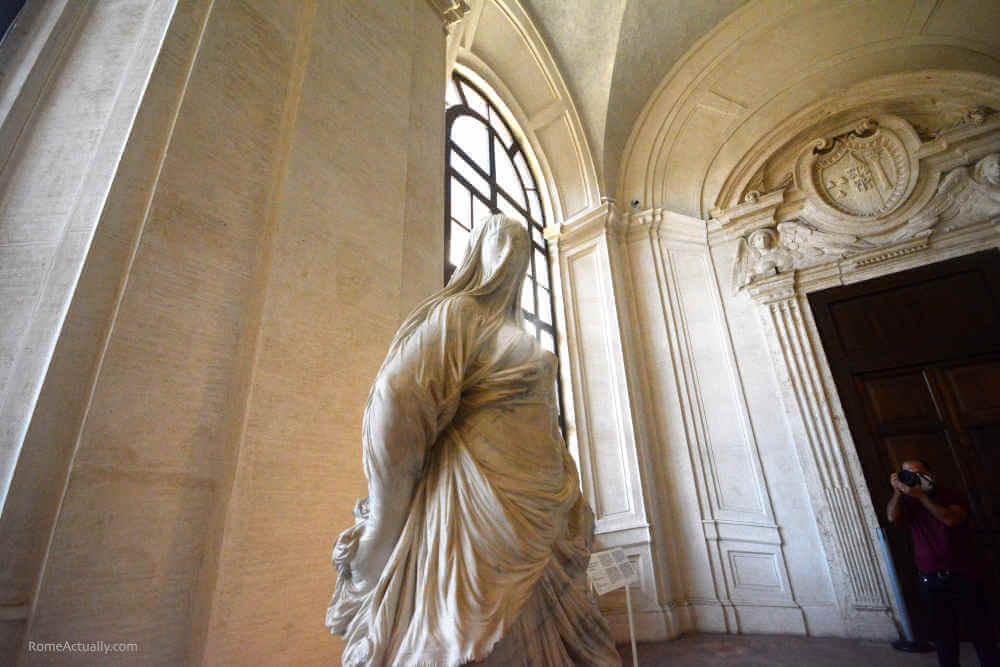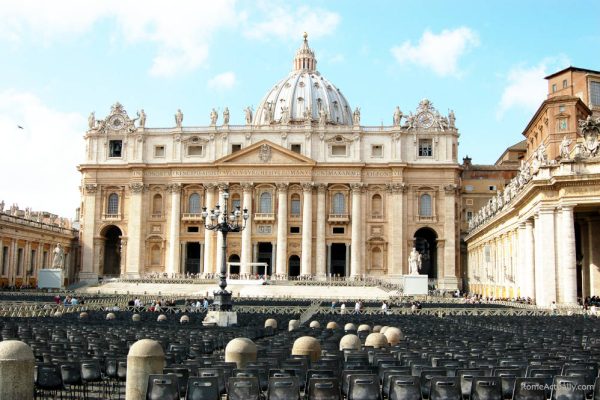Even though located in the very heart of the city, Palazzo Barberini doesn’t attract, in my opinion, as many visitors as it deserves. A sublime example of Italian Baroque architecture, the noble palace is the collaboration of three of the main architects of the 17th century: Carlo Maderno, Gian Lorenzo Bernini, and Francesco Borromini.
The palace became a seat of the Galleria Nazionale di Arte Antica in 1953, joining Galleria Corsini in Trastevere (Via della Lungara 10) which was such since 1895. Today, strolling the halls and corridors of Palazzo Barberini, you can view masterpieces dating between the 13th and 18th centuries.
Between family rows that caused the first scattering of the private collection and the royal decree in 1934 allowing noble clans to sell the masterpieces they owned, including to foreign buyers, the artwork on display at Palazzo Barberini has little left from the original collection of the Barberini family. The majority of the artwork dates to the 16th and the 17th centuries with masterpieces by artists of the likes of Raphael, Tintoretto, Caravaggio, Bronzino, Gian Lorenzo Bernini, Guido Reni, Guercino, and Pietro da Cortona.
Admittedly, this is not a landmark you are likely to include on your bucket list if you are staying in Rome for only a day, even if you are only seeing the city center. However, if you are spending three days in Rome or more, I definitely suggest carving one or two hours visiting this beautiful Rome museum steeped in history.

Palazzo Barberini History
The powerful Barberini clan didn’t actually originate from Rome but was a wealthy family from Tuscany known under the name “da Barberino”, later changed when the forefather, Antonio Da Barberino, father of the future Pope Urban VIII, moved to Rome in the 16th century.
To build what is now Palazzo Barberini, Pope Urban VIII bought Villa Sforza from the namesake noble Roman family and commissioned its revamping to the leading architect Carlo Maderno. Instead of flattening the existing aristocratic abode, Maderno built another wing and connected them through a central corridor giving the building the unusual H shape.
Palazzo Barberini’s history is also linked to the eternal rivalry that saw the two genius artists of the 17th century, the diplomatic Bernini and the whimsical Borromini, working side by side while constantly bickering and competing with each other.
Around mid 18th century, the last apartments in Rococo style were built on the last floor where the family lived until 1955.

What to See in Palazzo Barberini
A huge collection of artwork that includes paintings, sculptures and architectural marvels, take a stroll to see some representative Italian and international masterpieces. Here are some of the most famous.
- Giuditta e Oloferne (Judith Beheading Holophernes) by Caravaggio. Gory and dynamic, the painting shows the typical Caravaggio feature of light coming from the side. There has been some speculation that Caravaggio draw inspiration for this painting from the execution by beheading of the Roman patrician Beatrice Cenci sentenced to death in 1599 for killing her abusive father. While this can be possible because Caravaggio was in Rome at the time, some sources, including Michele Di Monte, a leading historian at Palazzo Barberini, disagree due to the uncertainty of the date of the painting (maybe it dates a year earlier than Cenci’s death) and because of the different “style” of the beheading. Holophernes, in fact, is using a sword, while Beatrice Cenci was killed with a primordial guillotine.

- La Fornarina by Raffaello Sanzio. This is believed to be the portrait of Margherita Luti, the daughter of a baker in Trastevere, whom Raphael fell in love with after seeing her bathing in the Tiber naked. At that time, Raffaello was working on the frescoes of the beautiful Renaissance Villa Farnesina for the Chigi family. Shrewd Agostino Chigi had noticed the several outings of the famous painter so he agreed to let Margherita Luti in as long as Raffaello kept working and to avoid further delays. With this portrait, Raphael managed to elude the conventional features of the time by choosing a subject that is not a goddess or a noblewoman but a simple, ordinary citizen. Much discussion has been made around this portrait, or better the identity the painter sought to convey. Some critics see it, in fact, as an unconventional self-portrait in that Raphael is present in the painting through several signs, the most telling of which being his signature on the woman’s armlet, but also in the fact that the subject of the portrait is his lover.

- (Alleged) Beatrice Cenci by Guido Reni. While for centuries this small woman’s portrait was thought to represent the young Beatrice Cenci on the eve of her beheading, this claim has been recently refuted. It was very unlike that Guido Reni would be allowed in Cenci’s prison on the day before her execution. The painting drew thousands of tourists, mostly English attracted by the sad story that turned Cenci into an anti-Catholic heroine, and was finally attributed to Bologna-born Ginevra Cantofoli, so subsequent to the story of Beatrice Cenci, who probably painted a sibyl prophetess.

- Il Trionfo della Divina Provvidenza By Pietro da Cortona. This giant fresco decorating the ceiling of the largest hall of the palace was painted between 1632 and 1639. In a mix of natural and human figures, historical events, and symbols, the artist aimed to involve the viewer in a visual adventure. And when you’ll see it, you will fully understand what this means: as you walk from one side to the other of the room, you will have the impression that the painting is moving, that it’s actually following you.
- Bernini’s Staircase. Once you visit the first hall, you have to go back down towards the exit and access the rest of the exhibition from another entrance, which is the majestic square-shaped stairway designed by Bernini.
- Borromini’s Staircase. There is no better way to round off this masterpiece-packed tour than exiting through the other elegant staircase, the one designed by Borromini, Bernini’s peer artist and lifetime rival. Unlike Bernini’s staircase, Borromini’s is spiral-shaped, a triumph of curves, in line with the eccentric style of the architectural genius.

- Narcissus by Caravaggio. In what became one of his most famous paintings, Caravaggio shows his genius by giving a new air to a common subject such as Narcissus, the young hunter who falls in love with his own image reflected in the water.
- La Velata (The Veiled) by Antonio Corradini. A gorgeous sculpture of a woman, probably a vestal virgin, whose marble veil is so imperceptible to look as if made of fabric.

- Portrait of Henry VIII by Hans Holbein the Younger. The famous portrait of the English king is another highlight in the Palazzo Barberini collection. From the inscription in the blue background, we see it was painted when the king was 49 years old on the occasion of his fourth marriage and it shows the power of the monarch as well as the talent of his personal painter in his attention to detail.
What to See near Palazzo Barberini
You are in the heart of the city but somehow far from the crowd that barely lets you walk, so take advantage and visit some of the
- Piazza Barberini. Right down Via delle Quattro Fontane is Piazza Barberini, one of Rome’s prettiest squares. Before moving on to your next landmark, stop to view the central Triton Fountain commissioned by Pope Urban VIII to Gian Lorenzo Bernini and the water of which was originally supplied by the Aqua Felix aqueduct.
- Via Veneto. This famous tree-lined long road sways from Piazza Barberini to Porta Pinciana, the historical gate through the 3rd-century walls of the city. Once the favorite hangout of 1960s celebrities, today its bars and outdoor restaurants look more like expensive tourist traps capitalizing on Hollywood nostalgia.
- Capuchin Crypt. In Via Veneto, close to Barberini metro station, is the church of Santa Maria della Concezione built by Cardinal Antonio Barberini belonging to the Capuchin Order and brother of Pope Urban VIII. The church is famous and attracts most visitors for its crypt, broadly known as the Capuchin Crypt, which houses and is decorated with the bones of thousands of Capuchin friars.
- Via del Tritone. Stretching from Piazza Barberini, Via del Tritone takes its name from Bernini’s Triton Fountain and is a fantastic shopping hub showcasing different mono-brand stores as well as La Rinascente luxury department store. In the undergrounds of La Rinascente, you can visit a fascinating archaeological digging that shows a piece of the ancient Aqua Virgo, the aqueduct that supplies water to the Trevi Fountain.
- Trevi Fountain. The gorgeous Baroque Fontana di Trevi, Rome’s largest and most famous, is a short and history-rich walk away. Along the way, you will be tempted to stop at eateries, gelaterias, ancient ruins and boutiques, but keep going and the wonderful water-gushing candid-white sculpture will bedazzle you.
- Spanish Steps. In about ten minutes from Palazzo Barberini, you will reach the Spanish Steps, an important landmark of Rome’s city center.
- Villa Borghese. Head all the way up Via Veneto and take a stroll in Villa Borghese, the gorgeous park once the luxury residence of the Borghese clan. Fountains, sculptures, gardens, belvedere points and museums make it one of the activity-rich parks, great for families also for its children’s playgrounds and the city’s zoo.

Where to Eat near Palazzo Barberini
Being this a busy area in the city center, there is always the risk to stumble on tourist menus and quality. Here are some of the best places to eat after your tour of Palazzo Barberini.
- Colline Emiliane. An upscale restaurant where you can tuck into the hearty dishes of the Reggio Emilia region from lasagne to tortellini.
- Piccolo Buco. A great pizza place and traditional Roman restaurant located a few minutes walk away from the Trevi Fountain. Mandatory booking whatever the season because it’s small and always packed.
- Mandaloun. The fans of Lebanese cuisine will be happy to know that near Porta Pinciana, all the way up Via Veneto, is Mandaloun, a great Middle Eastern restaurant serving lunch and dinner.
- Settimo. The luxury restaurant of Sofitel Villa Borghese 5-star hotel currently serves contemporary Roman cuisine every day for dinner.
- Moma. Located in Via di San Basilio, Moma serves innovative creations in line with tradition and local products in two concepts: casual bistrot and elegant fine dining.

Practical Information
- Address: Via delle Quattro Fontane 13.
- How to reach: Metro (Barberini stop, Line A), bus (52, 53, 61, 63, 80, 81, 83, 100, 150F, 160, 492, 590)
- Entrance fee: €10
- Opening hours: Tuesday-Sunday 10 am-6 pm. Closed Mondays, December 25th, January 1st.
- Photography: Taking photos is allowed (free of charge), shooting videos is not.




